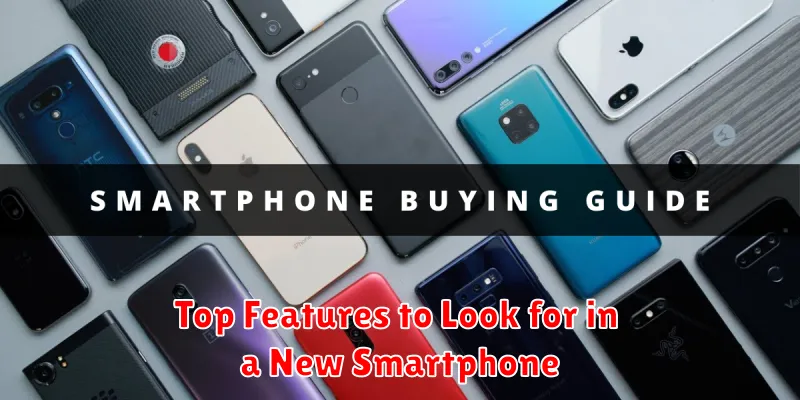Purchasing a new smartphone can be a daunting task, given the sheer volume of options available on the market. Making an informed decision requires careful consideration of several key features. This article will guide you through the top features to look for in a new smartphone, empowering you to select the perfect device that meets your individual needs and budget. From camera quality and battery life to processing power and storage capacity, we will cover the essential aspects to prioritize in your search for a new phone. Understanding these key smartphone features is crucial for a satisfying purchase experience.
Whether you are a tech enthusiast seeking the latest smartphone innovations, a casual user looking for a reliable communication device, or a professional requiring a powerful mobile workstation, understanding the top features is paramount. This guide will highlight the crucial elements to consider, such as display quality, operating system, security features, and 5G connectivity. By focusing on these essential features, you can effectively narrow down your choices and select a new smartphone that perfectly aligns with your requirements and provides optimal value for your investment.
Battery Life and Charging Speed
Battery life is a crucial factor when choosing a new smartphone. Look for a phone that offers all-day battery life under typical usage. Consider devices with a battery capacity of at least 4000mAh. Larger batteries generally translate to longer usage times.
Charging speed is equally important, especially if you’re constantly on the go. Fast charging technologies allow you to replenish a significant amount of power in a short time. Look for phones that support fast charging and consider the wattage of the charger included in the box or available for purchase.
Screen Size and Quality
Screen size and quality are crucial factors influencing your smartphone experience. Size impacts usability and media consumption, while resolution and display technology affect clarity and vibrancy.
Consider your usage habits. Larger screens (6 inches and above) are ideal for media consumption and multitasking, but may be less pocketable. Smaller screens offer better one-handed use.
Look for higher resolutions (Full HD+ or QHD+) for sharper images and text. Display technology such as AMOLED generally offer better contrast and color accuracy than LCDs. Also, consider the refresh rate, with higher rates (90Hz or 120Hz) providing smoother scrolling and animations.
Camera Performance

Camera performance is a critical factor for many smartphone buyers. Consider several key specifications when evaluating camera quality.
Megapixels: While not the sole indicator of quality, higher megapixel counts generally allow for larger prints and more detailed images. Look for at least 12MP for the main rear camera.
Aperture: A lower aperture number (e.g., f/1.8) indicates a wider aperture, allowing more light to reach the sensor. This results in better low-light performance and improved depth-of-field effects.
Image Stabilization: Optical image stabilization (OIS) or electronic image stabilization (EIS) helps reduce blur caused by shaky hands, leading to sharper images, especially in low light or when using zoom.
Processing Power and RAM
A smartphone’s processing power, often measured in gigahertz (GHz), determines how quickly it can execute tasks. A higher GHz generally translates to smoother performance, especially when running demanding applications or multitasking. Look for processors from reputable manufacturers known for their performance and efficiency.
RAM (Random Access Memory) is equally crucial. It dictates how many apps and processes your phone can hold in its active memory. More RAM means less frequent app reloading and a smoother overall user experience. Consider a minimum of 6GB of RAM for decent performance, while 8GB or more is ideal for power users.
Operating System Preferences
A smartphone’s operating system (OS) significantly impacts user experience. The most popular choices are Android and iOS, each offering distinct advantages.
iOS, developed by Apple, is known for its user-friendly interface, robust security features, and seamless integration with other Apple devices. It typically receives longer software support than Android.
Android, developed by Google, provides greater customization options, wider device compatibility across various manufacturers, and more flexibility in managing files and apps.
Consider your priorities when choosing an OS. Do you value simplicity and security or customization and flexibility? Researching both operating systems will help determine which best suits your needs.
Storage Options and Expandability
Internal storage plays a crucial role in a smartphone’s performance and ability to store apps, photos, and videos. Consider your usage patterns when selecting a phone. Options commonly range from 64GB to 512GB or even 1TB in some high-end models.
Expandable storage via a microSD card slot provides flexibility to increase storage capacity as needed. This can be a cost-effective way to add more space, especially if you deal with large files regularly. Check if the smartphone supports expandable storage and what capacity cards are compatible.
Build Quality and Durability
A smartphone’s build quality significantly impacts its longevity and resistance to daily wear and tear. Look for phones constructed with durable materials such as aluminum or high-quality polycarbonate.
Consider devices with added protection like Gorilla Glass for the screen and an IP rating for water and dust resistance. A higher IP rating indicates better protection.
Check for tight seams and a solid feel in hand, indicating good construction and potential resistance to flexing or creaking.
Security Features

Smartphone security is crucial for protecting your personal data. Look for features like a fingerprint sensor, facial recognition, or an iris scanner for convenient and secure unlocking.
Beyond biometric authentication, consider the operating system’s security updates. A phone that receives regular updates is better protected against emerging threats. Also, look for features like a secure folder or privacy dashboard, which provide granular control over app permissions and data access.
Price vs. Features Balance
Finding the right smartphone involves a careful balancing act between price and features. Budget is a primary concern for most consumers. However, compromising too much on features for a lower price can lead to dissatisfaction in the long run.
Consider which features are essential for your needs. A powerful processor is crucial for gamers, while a high-quality camera is vital for photography enthusiasts. Prioritize these must-have features and be prepared to pay a premium if necessary.
Conversely, some features may be less important. For example, a large amount of storage might be unnecessary if you primarily use cloud services. By identifying these non-essential features, you can potentially save money without sacrificing overall satisfaction.
Warranty and Support Services
A comprehensive warranty and robust support services are crucial when investing in a new smartphone. Warranty coverage typically protects against manufacturer defects for a specified period, often one year. Look for warranties that cover both parts and labor.
Beyond the standard warranty, consider extended warranty options. These provide coverage beyond the initial period, offering added peace of mind. However, evaluate the cost versus the potential benefits.
Customer support is another essential factor. Research the manufacturer’s reputation for responsiveness and helpfulness. Check for accessible support channels like phone, email, or online chat. Prompt and efficient customer service can prove invaluable if you encounter issues with your device.

